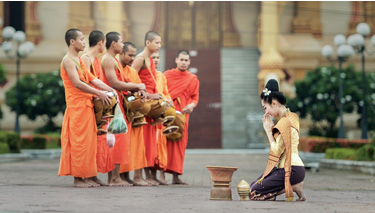GETTING AROUND IN VIETNAM
Though still a little rough around the edges, Vietnam’s transportation network continues to improve. Land vehicles are sturdy, the domestic flight network continues to evolve, and the prices are reasonable.
Plane
Vietnam Airlines and Pacific Airlines are the two main domestic carriers. Fares are very reasonable and the frequency of flights to main hubs is good. Flights can be a handy way to lop off a day of travel for not as many Dongs as you may expect; Hanoi to Dien Bien Phu, and Saigon to Phu Quoc Island are both popular time-savers. Note that it is often cheaper to buy domestic tickets in Vietnam than from online brokers.
Train
Vietnam’s train system is a lot better than is used to be, and while it is not cheap per se, it is comfortable, exceedingly scenic in places, and overall, a very interesting and fun way to travel. If you are traveling during high season or during Tet, book as far in advance as possible. The train railways run primarily on the Vietnamese coastline, with just a couple of spurs out of Hanoi, most notably northwest to Sapa. The coastal line serves many of the key destinations in Vietnam, although the notable exceptions are Hoi An (alight at Da Nang), Qui Nhon (alight at Dieu Tri) and Mui Ne (alight at Muong Man).
Local buses and minibuses
These take about as long as Open Tours but can be overloaded to outrageous degrees. Local buses and minibuses are fine for trips under three to four hours, but longer than that can be a bit grueling. One disadvantage of the local bus system is that the bus station hubs that they operate from are often on the outskirts of town and the transportation to and from these hubs (‘xe om’) will put a significant dent in your wallet, reducing any savings you might hope to achieve.
Rental car
Rental cars for long distance travel are yet to be popularized in Vietnam, and seeing the state of the traffic it’s easy to see why. For those who prefer to self-cater, it is recommended to do it via motorcycle rather than car.
Motorbike
Grab a Minsk and hit the road. These bikes can be purchased for as little as a few hundred US dollars and you’ll often find it easy to sell the bike off to another traveler when the time comes to leave Vietnam. These bikes are semi-reliable, but just about any local with a screwdriver should be able to fix it up should you have any minor troubles. For your safety, invest in a helmet which can be easily purchased in both Hanoi and Saigon.
Bicycle
Long, with a scenic flat coastline, Vietnam is a great destination for cyclists. The only grueling part is the northern mountains – even the Central Highlands are not really all that hilly. Every town in Vietnam offers some form of accommodations, so finding a room for the night shouldn’t be difficult. Make sure to pack a good supply of inner tubes and patch kits and if possible, bring your own bike as Vietnamese bikes are not top tier. The country has a good network of secondary roads which are far preferable to the main roads, where cyclists rank just above chickens in the pecking order (pun fully intended); cyclists are expected to yield to all larger vehicles.
Boat
This is really only an option in the Mekong Delta, where you can travel in boats for short haul trips and take freighters for longer trips; the former are usually more comfortable. Boat transport is slow – set aside two days for a trip from My Tho to Chau Doc on the Cambodian border. The most popular routes are the ferry from Ho Chi Minh City to Vung Tau, and the boats from Chau Doc to Phnom Penh. Boat travel generally works out to be more expensive than bus travel for the same route.
